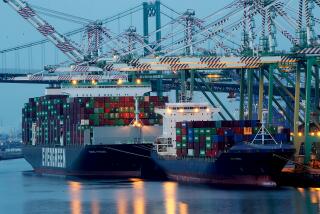Power and water donŌĆÖt mix
A recent audit of the Los Angeles Department of Water and Power by City Controller Wendy Gruel criticized the agency for its lack of transparency. The DWP, she concluded, has ŌĆ£lost the trust of the public.ŌĆØ
And why shouldnŌĆÖt the public have lost trust? Long before the DWPŌĆÖs recent fight with the mayor and City Council over rate hikes, the agency had ceased to inspire confidence. The utility burned through nine general managers in 10 years, during which time maintaining the status quo was a much higher priority than moving the City forward. No wonder DWPŌĆÖs popularity currently resides somewhere between the DMV and BP.
Even though the DWP is finally beginning to embrace the mayorŌĆÖs ambitious and commendable goals of weaning the city from the use of coal and dramatically increasing its renewable energy portfolio to 40% by 2020, it has dragged its heels on other issues ŌĆö particularly where water is concerned.
So letŌĆÖs consider something radical: Perhaps the DWP simply has too big and complex a job. The city should separate water and power into two departments. Few issues are as important to the well-being of our region as water. And as the effects of climate change on the Sierra snowpack and the increased demands of a growing population put ever-increasing stress on the water supply, the city deserves better than efforts of the DWP. The utility has a dismal record on providing local sustainable sources of water from water recycling, aquifer management and rainwater capture. Even its basic management of water supply infrastructure is underwhelming. The DWPŌĆÖs pretty good record on water conservation cannot alone move the City to sustainable water management, The City still imports far too much Sacramento Delta and Colorado River water from the Metropolitan Water District ŌĆö at considerably higher expense than local supplies and a far greater environmental cost.
The example of water recycling particularly illustrates the problem. The cityŌĆÖs Bureau of Sanitation produces high-quality reclaimed water at three of its four treatment plants, yet only a minute fraction of that water is reused, in large measure because the DWP fails to coordinate with other city agencies. As a result, only about 1% of the cityŌĆÖs water supply is from recycled water. Compare this with Orange County and the Inland Empire, which rely on recycled water for 20% or more of their water supplies. DWP progress on increasing the use of recycled water has stalled at a time when new technologies such as microfiltration and reverse osmosis have addressed even the most irrational toilet-to-tap fears.
The underlying problem in all of this is that responsibility for water management in Los Angeles is split between two agencies ŌĆö the Department of Public Works and the DWP ŌĆö with very different missions and approaches. As a result, coordination of infrastructure projects and integrated watershed management efforts is inefficient and especially ineffective for water recycling and storm water capture. Putting all water issues under one roof would mean that sewage, storm water, flood control, water recycling, conservation efforts and drinking water could be managed in concert, which would produce far greater efficiency.
The good news is that some city agencies are moving ahead even as the DWP dawdles. The cityŌĆÖs Department of Public Works, for example, has made great strides in removing pollutants from sewage and dry weather runoff, while at the same time moving forward on storm water pollution prevention efforts and green infrastructure projects to augment groundwater supplies and enhance flood control. For example, Public Works has crafted the Low Impact Development ordinance pending in the City Council and has designed and is constructing numerous rainwater capture projects under Proposition O, the cityŌĆÖs watershed protection bond.
Given Public WorksŌĆÖ effectiveness and proven commitment to a sustainable watershed management approach, it would be logical to move responsibility for managing all the cityŌĆÖs water needs to that department. The department already manages flood control, storm water and wastewater, so adding responsibility for water supply is a logical extension of its mandate.
Massive reorganizations are never easy, especially in a city as complex and bureaucratic as Los Angeles. But the environmental and economic benefits would be worth the headache. As CaliforniaŌĆÖs water crisis intensifies, a stable water supply will become more important than ever. A phased-in transfer of responsibilities from the DWP to Public Works could be achieved by 2015, and could in the end save the city money.
Mark Gold is the president of Heal the Bay.
More to Read
Sign up for Essential California
The most important California stories and recommendations in your inbox every morning.
You may occasionally receive promotional content from the Los Angeles Times.










